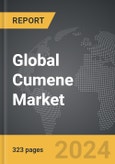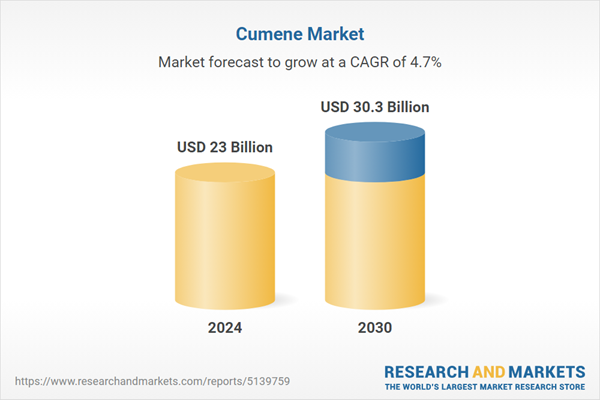The global market for Cumene was valued at US$23.0 Billion in 2024 and is projected to reach US$30.3 Billion by 2030, growing at a CAGR of 4.7% from 2024 to 2030. This comprehensive report provides an in-depth analysis of market trends, drivers, and forecasts, helping you make informed business decisions. The report includes the most recent global tariff developments and how they impact the Cumene market.
Segments: Production Technology (Zeolite, Solid Phosphoric Acid, Aluminum Chloride); Application (Phenol / Acetone, Other Applications).
Geographic Regions/Countries: World; United States; Canada; Japan; China; Europe (France; Germany; Italy; United Kingdom; Spain; Russia; and Rest of Europe); Asia-Pacific (Australia; India; South Korea; and Rest of Asia-Pacific); Latin America (Argentina; Brazil; Mexico; and Rest of Latin America); Middle East (Iran; Israel; Saudi Arabia; United Arab Emirates; and Rest of Middle East); and Africa.
The analysts continuously track trade developments worldwide, drawing insights from leading global economists and over 200 industry and policy institutions, including think tanks, trade organizations, and national economic advisory bodies. This intelligence is integrated into forecasting models to provide timely, data-driven analysis of emerging risks and opportunities.
Global Cumene Market - Key Trends and Drivers Summarized
Cumene: The Foundation of Modern Synthetic Resins and Antioxidants
Cumene, also known as isopropylbenzene, plays a fundamental role in the chemical industry as a precursor to more complex chemicals, most notably phenol and acetone. The production of cumene involves the alkylation of benzene with propylene, typically using acidic catalysts. This process, known as the cumene process, is critically important because phenol and acetone serve as key ingredients in the manufacture of plastics, synthetic fibers, and rubber, as well as in the production of bisphenol A, which is used to make polycarbonate plastics and epoxy resins. The versatility of cumene in creating high-demand chemicals makes it a staple in industrial applications and a focus for chemical engineering innovations aimed at improving yield and reducing environmental impact.What Advancements Are Influencing Cumene Production Methods?
The efficiency of cumene production has seen significant advancements, particularly with the development of more effective catalysts and process optimizations that reduce energy consumption and byproduct formation. Modern catalytic technologies have enabled more selective reactions, which enhance the purity of cumene and minimize the production of unwanted byproducts. Additionally, environmental concerns have driven improvements in how cumene production facilities manage emissions and waste, leading to cleaner processes and compliance with stricter global environmental standards. These technological improvements not only enhance the production efficiency but also support the sustainability goals of chemical manufacturers.How Does Cumene Impact Environmental and Safety Standards?
While cumene is valuable industrially, it poses environmental and safety risks that must be carefully managed. It is classified as a volatile organic compound (VOC) with potential health risks if inhaled or handled improperly. Thus, stringent safety protocols and handling procedures are essential in its production and use. Environmental regulations also govern the emission of cumene during production to prevent air and water pollution. Ongoing research is focused on finding ways to mitigate these risks through safer chemical processes and better containment methods, ensuring that the benefits of cumene can be enjoyed without undue harm to health or the environment.What's Driving the Surge in Demand for Cumene?
The growth in the cumene market is driven by several factors, including the expanding global demand for phenol and acetone derivatives used in the automotive, electronics, and construction industries. The rise in consumer electronics sales, for instance, boosts the need for polycarbonate plastics and epoxy resins - both of which rely on cumene-derived products. Additionally, innovations in cumene production processes that offer greater efficiency and environmental compliance are making it more cost-effective and appealing to manufacturers. These technological advancements, coupled with growing industrial markets in emerging economies, are significant contributors to the robust growth of the cumene industry.Report Scope
The report analyzes the Cumene market, presented in terms of units. The analysis covers the key segments and geographic regions outlined below.Segments: Production Technology (Zeolite, Solid Phosphoric Acid, Aluminum Chloride); Application (Phenol / Acetone, Other Applications).
Geographic Regions/Countries: World; United States; Canada; Japan; China; Europe (France; Germany; Italy; United Kingdom; Spain; Russia; and Rest of Europe); Asia-Pacific (Australia; India; South Korea; and Rest of Asia-Pacific); Latin America (Argentina; Brazil; Mexico; and Rest of Latin America); Middle East (Iran; Israel; Saudi Arabia; United Arab Emirates; and Rest of Middle East); and Africa.
Key Insights:
- Market Growth: Understand the significant growth trajectory of the Zeolite Technology segment, which is expected to reach US$16.8 Billion by 2030 with a CAGR of a 5.7%. The Solid Phosphoric Acid Technology segment is also set to grow at 4.0% CAGR over the analysis period.
- Regional Analysis: Gain insights into the U.S. market, valued at $6.0 Billion in 2024, and China, forecasted to grow at an impressive 7.5% CAGR to reach $6.8 Billion by 2030. Discover growth trends in other key regions, including Japan, Canada, Germany, and the Asia-Pacific.
Why You Should Buy This Report:
- Detailed Market Analysis: Access a thorough analysis of the Global Cumene Market, covering all major geographic regions and market segments.
- Competitive Insights: Get an overview of the competitive landscape, including the market presence of major players across different geographies.
- Future Trends and Drivers: Understand the key trends and drivers shaping the future of the Global Cumene Market.
- Actionable Insights: Benefit from actionable insights that can help you identify new revenue opportunities and make strategic business decisions.
Key Questions Answered:
- How is the Global Cumene Market expected to evolve by 2030?
- What are the main drivers and restraints affecting the market?
- Which market segments will grow the most over the forecast period?
- How will market shares for different regions and segments change by 2030?
- Who are the leading players in the market, and what are their prospects?
Report Features:
- Comprehensive Market Data: Independent analysis of annual sales and market forecasts in US$ Million from 2024 to 2030.
- In-Depth Regional Analysis: Detailed insights into key markets, including the U.S., China, Japan, Canada, Europe, Asia-Pacific, Latin America, Middle East, and Africa.
- Company Profiles: Coverage of players such as Axiall Corporation, BASF SE, BP PLC, Dow, Inc., DuPont de Nemours, Inc. and more.
- Complimentary Updates: Receive free report updates for one year to keep you informed of the latest market developments.
Some of the 42 companies featured in this Cumene market report include:
- Axiall Corporation
- BASF SE
- BP PLC
- Dow, Inc.
- DuPont de Nemours, Inc.
- Exxon Mobil Corporation
- Royal Dutch Shell PLC
- SABIC (Saudi Basic Industries Corporation)
- Sumitomo Chemical Co., Ltd.
- Total SA
Tariff Impact Analysis: Key Insights for 2025
Global tariff negotiations across 180+ countries are reshaping supply chains, costs, and competitiveness. This report reflects the latest developments as of April 2025 and incorporates forward-looking insights into the market outlook.The analysts continuously track trade developments worldwide, drawing insights from leading global economists and over 200 industry and policy institutions, including think tanks, trade organizations, and national economic advisory bodies. This intelligence is integrated into forecasting models to provide timely, data-driven analysis of emerging risks and opportunities.
What’s Included in This Edition:
- Tariff-adjusted market forecasts by region and segment
- Analysis of cost and supply chain implications by sourcing and trade exposure
- Strategic insights into geographic shifts
Buyers receive a free July 2025 update with:
- Finalized tariff impacts and new trade agreement effects
- Updated projections reflecting global sourcing and cost shifts
- Expanded country-specific coverage across the industry
Table of Contents
I. METHODOLOGYII. EXECUTIVE SUMMARY2. FOCUS ON SELECT PLAYERSIII. MARKET ANALYSISSOUTH KOREAREST OF ASIA-PACIFICARGENTINABRAZILMEXICOREST OF LATIN AMERICAIRANISRAELSAUDI ARABIAUNITED ARAB EMIRATESREST OF MIDDLE EASTIV. COMPETITION
1. MARKET OVERVIEW
3. MARKET TRENDS & DRIVERS
4. GLOBAL MARKET PERSPECTIVE
UNITED STATES
CANADA
JAPAN
CHINA
EUROPE
FRANCE
GERMANY
ITALY
UNITED KINGDOM
SPAIN
RUSSIA
REST OF EUROPE
ASIA-PACIFIC
AUSTRALIA
INDIA
LATIN AMERICA
MIDDLE EAST
AFRICA
Companies Mentioned (Partial List)
A selection of companies mentioned in this report includes, but is not limited to:
- Axiall Corporation
- BASF SE
- BP PLC
- Dow, Inc.
- DuPont de Nemours, Inc.
- Exxon Mobil Corporation
- Royal Dutch Shell PLC
- SABIC (Saudi Basic Industries Corporation)
- Sumitomo Chemical Co., Ltd.
- Total SA
Table Information
| Report Attribute | Details |
|---|---|
| No. of Pages | 323 |
| Published | April 2025 |
| Forecast Period | 2024 - 2030 |
| Estimated Market Value ( USD | $ 23 Billion |
| Forecasted Market Value ( USD | $ 30.3 Billion |
| Compound Annual Growth Rate | 4.7% |
| Regions Covered | Global |









